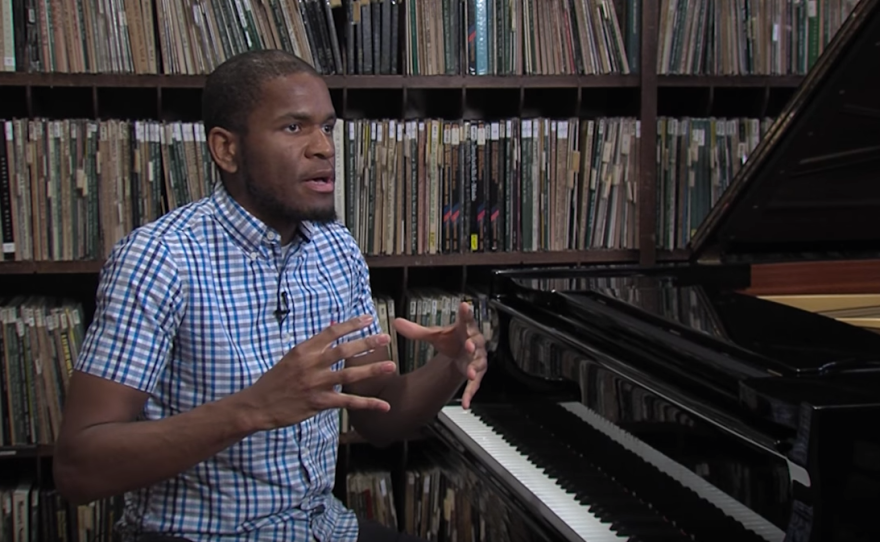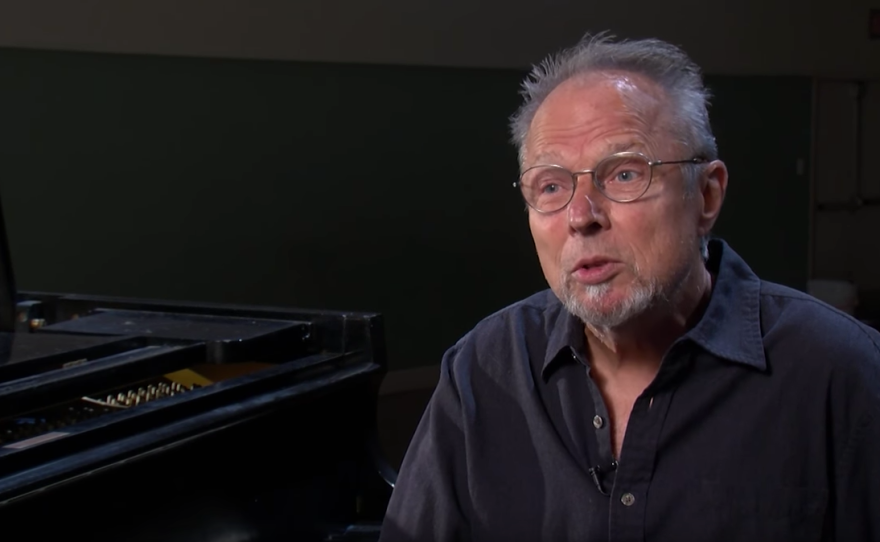Joshua White sits at a grand piano in a large room that is enclosed by walls full of shelves and books. He plays a tune that is fast and abstract then downshifts to a jazz ballad.
The room is a library, but it is also a jazz club.
“In San Diego one of my favorite music venues is where we’re currently speaking, the Athenaeum Music and Arts Library,” White said. “One, because I love this beautiful Steinway piano. And two, the room has a certain intimate quality and a resonance, sonically.”
Jazz venues in San Diego range from Jacobs Music Center, home of the San Diego Symphony, to academic settings to Hillcrest bars and wandering venues that are always in search of a home. But there are things the good ones all share.
“That connection. That feeling. The vibe. That church vibe,” trumpeter Gilbert Castellanos said. “Because every time I play, I’m on the altar of joy. And that’s the stage.”

Joshua White is a tall young man with a serious face, and he is very serious about his music. He will not even call it jazz because that would restrict his ability to express. He said when a venue stops presenting music — or loses its lease — the jazz community loses one of its moorings.
“They in themselves don’t necessarily sustain the community. They perpetuate a sense of continuity and consistency that helps the community at large survive through ups and downs.”
He points out those moorings are not just buildings, they are the people who bridge the gap between jazz and major institutions in San Diego.
“Whether it’s Gilbert Castellanos and the San Diego Symphony or Gilbert Castellanos and the San Diego of Art through Panama 66 and his jam sessions on Wednesday evenings,” White said.
Panama 66
It is Wednesday evening.
Panama 66 is in an open-sky courtyard next to the San Diego Museum of Art in Balboa Park. Castellanos is blowing his horn with a bass, piano and drums. Tables and chairs surround the bandstand. There is a bar serving beer and wine, and everybody is here.
The jam session opened with a group of some students of Gilbert Castellanos who attend the International Academy of Jazz. One of them is 16-year-old Johnny Steele, a tall kid with blond hair whose terrific drum solo filled the place a few minutes before we spoke.
“I really like playing in this open environment. It’s very relaxed, and you’re getting to play with some of the best musicians in San Diego,” Steele said. “Some of my favorite musicians, who just happen to live here. It’s an awesome experience.”
In San Diego, the jazz scene relies on a scattering of venues that include the Plaza Bar of the Westgate Hotel and Bread and Salt in Barrio Logan, whose jazz programs are hosted by the Athenaeum Art Center. Jazz may have begun in dance halls and brothels, but today, it finds a life in the halls of classical music.
“A concert hall is a perfect place to hear jazz!” Megan Swann said about the pulse of the music at Panama 66. She is an artistic planner for the symphony.
“You get to tune in without the crowd talking. Without the bar service and everything, and you get to listen to every note and how it blends and how every note bounces around a huge space,” she said.
When asked what makes a good jazz venue, David Jansen, the entertainment director for Martini’s Above Fourth in Hillcrest, said, “Great sound!”
Dizzy’s
There's another club that has been a pillar of the local scene. Dizzy's, founded in 1999, by Chuck Perrin.
“I think at Dizzy’s, I’ve — over the 17 years — done a little over 3,000 shows,” Perrin said as he sat by a piano on the stage of his dark, empty club.
Those shows he mentioned included pianist Mose Allison, singer and grammy winner Gregory Porter and drummer Joe Morello, who performed with Dave Brubeck.

Unlike Pamana 66, Dizzy’s does not serve drinks.
"When you come to a show at Dizzy's there's no talking or kibitzing or anything. It's all about listening to the music," Perrin said.
But Dizzy’s journey of 17 years has not been just a musical one. It has been forced to move from place to place. It started at a brick warehouse building downtown. Then, it moved to a place across from the Convention Center. Its strangest location was a former car dealership on Mission Bay that rented Jet Skis and U-Haul vans. Now Dizzy’s is located on Morena Boulevard, in a performing hall owned by the musician’s union.
Perrin’s loss of venues has been partly due to the hand of fortune. He said the 7th Street address got very expensive once the Petco Park redevelopment got underway. Perrin describes the economics of his club as a partnership with musicians.
“I set it up to be an artists-driven collective,“ he said. “The artists present their own events. I just facilitate making it happen. So they set the parameters of the event: when it starts, how long it is, how much the cover charge is.”
Dizzy’s takes a portion of the cover charge. The question for musicians is how big a financial cut the house takes. Perrin does not make money from alcoholic drinks because he doesn’t serve it at his shows, and his deal with musicians is fine for some and not for all. Joshua White performs there as a headline act. Castellanos does not.

Perrin said he hopes he can stay in his current space "forever." The business representative for the musician’s union said they consider accommodating Dizzy’s to be a good form of outreach to the music community. But it is controversial since many of the jazz musicians who perform there are not union members.
Gilbert’s Scene
San Diego has been home to a long list of jazz luminaries, past and present, including legendary sax players James Moody and Daniel Jackson, both of whom recently died, and the still-active Charles McPherson.
Gilbert Castellanos, who warms up on his trumpet one morning in his Normal Heights, is still drafting his own San Diego legend, and he is more than an artist. He teaches youngsters at San Diego’s International Academy of Jazz. He “curates” Jazz at the Jacobs, a series that brings international talent to the Jacobs Music Center. This season they have brought in, for one, the Count Basie Orchestra.
Castellanos said he has a bottom line for any place you hear jazz
“It’s a room where people are really listening to what is happening, where it’s an interaction with not just the musicians on the stage but an interaction with an audience. That’s extremely important because I personally feed off the energy.”
Those rooms and that energy are all over the place in San Diego.







